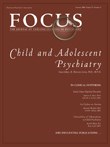From the Guest Editor
“The modern world for all its opportunities, benefits, and promises for a brighter future is full of circumstances that build major frustrations into childhood and adolescence. What will give a young person a sense of personal worth that will prevent destructive solutions to problems?”
The modern world presents numerous challenges for the child psychiatrist. Emergency room studies have shown that the level of children and adolescents presenting with psychotic disorders or suicidal attempts has remained relatively constant over the past 50 years and yet the level of those presenting with disruptive behavioral disorders and self-inflicted injuries has increased sharply.
New psychopharmacological advances, often helpful in alleviating symptoms, have created an environment in which children's behaviors are increasingly medicalized and both professionals and the lay public are expecting patterns of behavior to be “fixed” by pills. There is a growing trend for parents to expect mental health providers to offer structure, discipline, and even punishment that was traditionally a function of the home. Frequently, inpatient hospitalizations are used by frustrated parents to provide respite for themselves rather than to provide treatment for the child's bona fide psychiatric illness.
Progress in understanding child psychopathology and advancements in treatment of child and adolescent disorders have been brisk and robust. When untreated, these disorders can create a sense of low self-esteem, an inability to relate to others socially, and feelings of hopelessness, helplessness, and even rage.
Rates of teen suicide have been shown to decrease with the use of antidepressants and even more so with the combination of antidepressants and cognitive behavior therapy. In this issue of Focus, you will learn about our current understanding of the many major psychiatric illnesses of childhood and adolescence and their treatments and how we are able to improve outcomes. Of particular interest in this issue are autism and bipolar disorder.
Our ability to help children is improving. Our specific responsibility as psychiatrists and as fellow human beings is to help these children and their families who seek treatment. We must share our growing expertise and empower families to join us in making children's lives more healthy.



